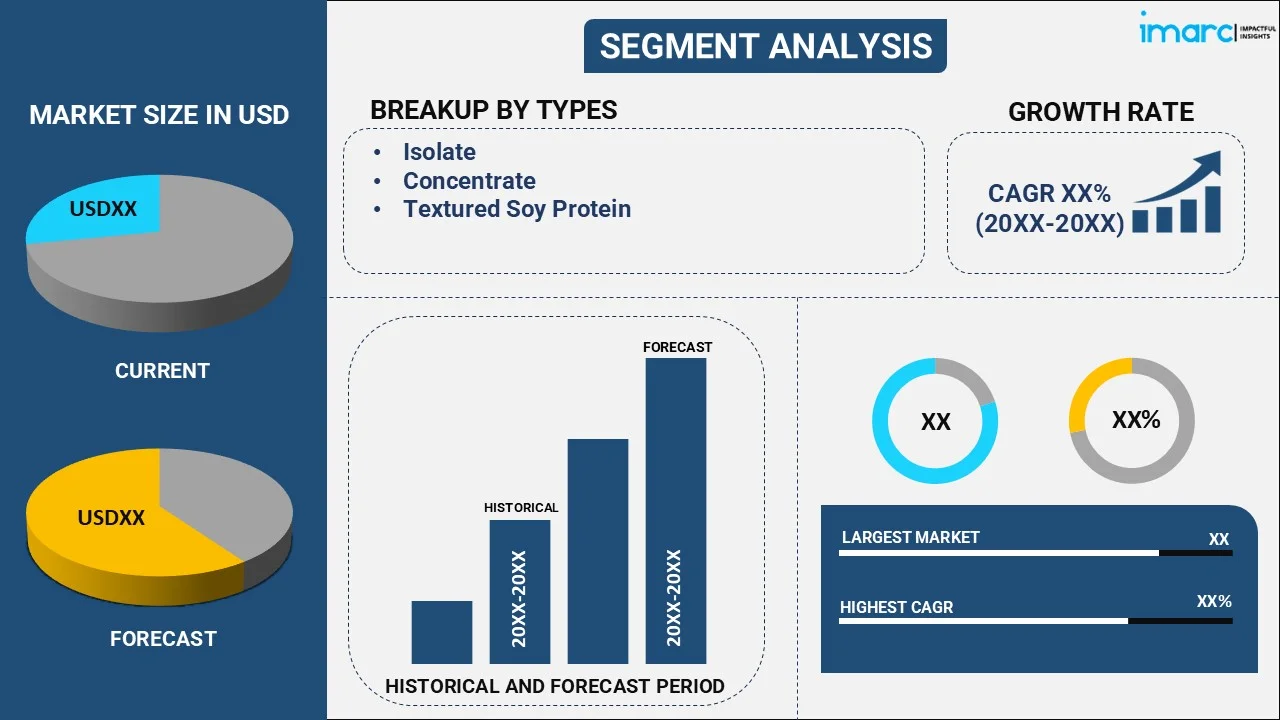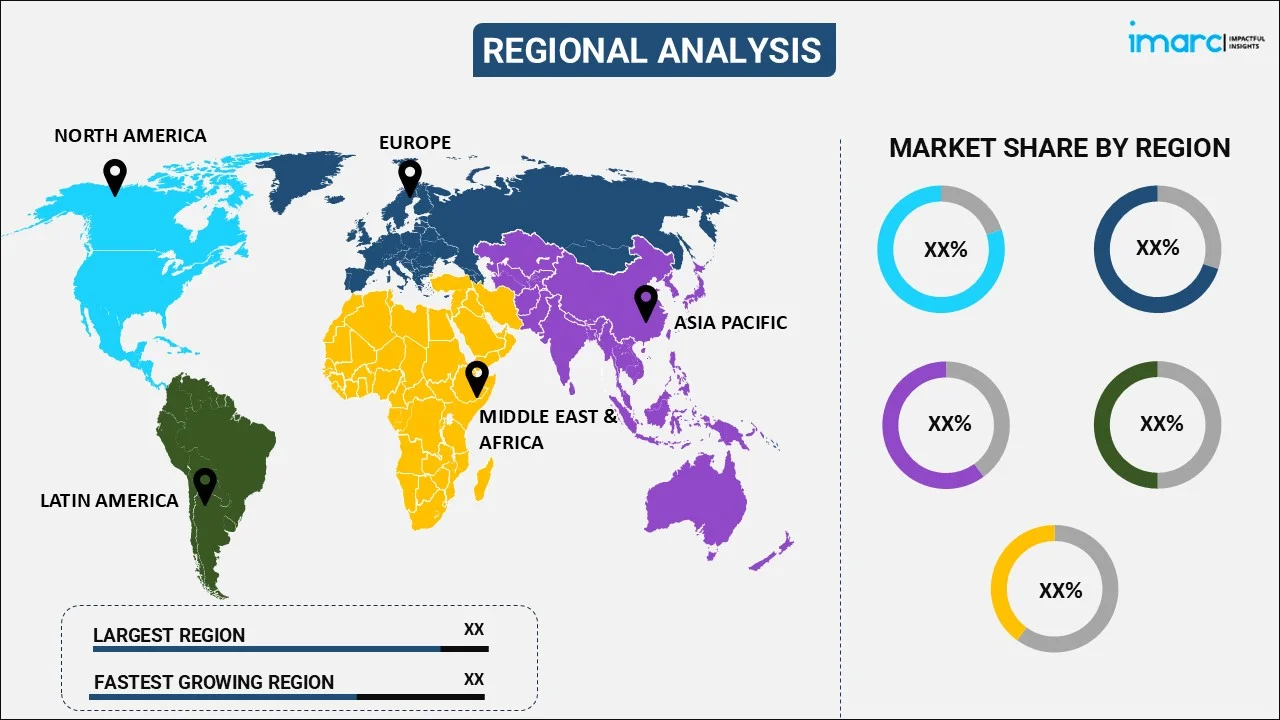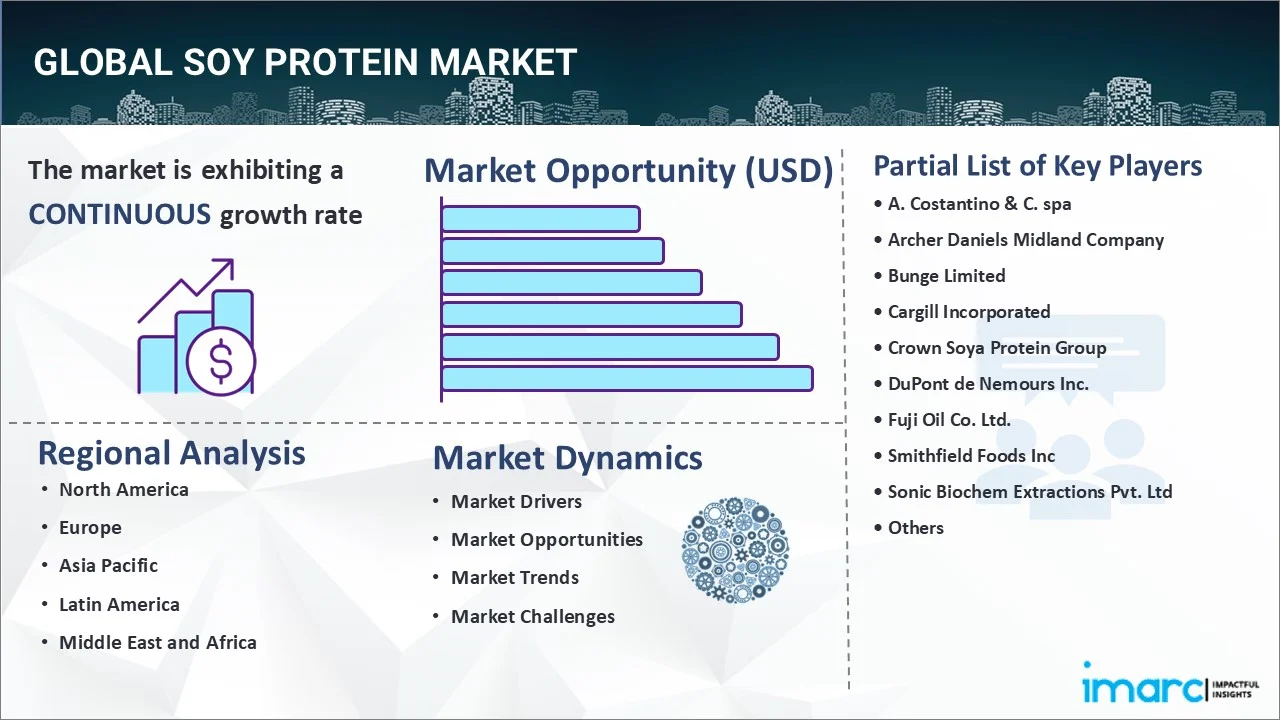
Soy Protein Market Report by Type (Isolate, Concentrate, Textured Soy Protein), Form (Powder, Bars, Ready-to-Drink, Capsules and Tablets, and Others), Nature (Organic Soy Protein, Conventional Soy Protein), Distributional Channel (Supermarkets/Hypermarkets, Convenience Stores, Online Stores, and Others), Application (Bakery and Confectionery, Functional Foods, Pharmaceuticals, Meat Additives, Feed, and Others), and Region 2025-2033
Market Overview:
The global soy protein market size reached USD 10.0 Billion in 2024. Looking forward, IMARC Group expects the market to reach USD 18.4 Billion by 2033, exhibiting a growth rate (CAGR) of 6.93% during 2025-2033. Increasing consumer awareness regarding the health benefits associated with soy protein, the rising prevalence of lifestyle diseases, and the growing focus on a healthy diet represent some of the key factors driving the market.
|
Report Attribute
|
Key Statistics
|
|---|---|
|
Base Year
|
2024
|
|
Forecast Years
|
2025-2033
|
|
Historical Years
|
2019-2024
|
|
Market Size in 2024
|
USD 10.0 Billion |
|
Market Forecast in 2033
|
USD 18.4 Billion |
| Market Growth Rate 2025-2033 | 6.93% |
Soy protein is a type of protein derived from soybeans that is widely consumed as a dietary supplement. It contains essential amino acids that the human body requires for growth and maintenance. The process of making soy protein involves removing the fat and carbohydrates from soybeans, leaving behind a high-protein powder. The resulting soy protein isolate is commonly used in protein bars, shakes, and other supplements. It is a great source of protein for vegetarians and vegans and is also low in fat and contains no cholesterol, making it a heart-healthy choice. Regular consumption of soy protein can help reduce the risk of heart disease, minimize cholesterol levels, and promote healthy bones. Currently, there are a wide variety of product variants available, including soy protein isolate, soy protein concentrate, and textured soy protein.
Soy Protein Market Trends:
The global soy protein market is primarily influenced by the increasing consumer awareness regarding the health benefits associated with soy protein, such as its high nutritional value and potential to reduce cholesterol levels. Moreover, the rising prevalence of lifestyle diseases and a growing focus on healthy eating habits are propelling the market growth. Additionally, the expanding vegan and vegetarian population, along with the surging trend of plant-based diets, are fueling the market growth. Furthermore, the extensive product application in various industries, including food and beverages (F&B), pharmaceuticals, and food processing industries owing to its various functional properties, such as emulsification, foaming, and gelling, are boosting the market growth. Moreover, various advancements in food processing and ingredient technologies to enhance the quality, taste, and texture of soy protein products are providing an impetus to the market growth. Furthermore, government initiatives and regulations promoting the consumption of plant-based proteins, rapid advancements in processing technologies, rising disposable income, growing urbanization, changing dietary preferences and easy product availability in supermarkets, hypermarkets, and online retail stores are accelerating the market growth.
Key Market Segmentation:
IMARC Group provides an analysis of the key trends in each sub-segment of the global soy protein market report, along with forecasts at the global, regional and country level from 2025-2033. Our report has categorized the market based on type, form, nature, distribution channel and application.
Type Insights:

- Isolate
- Concentrate
- Textured Soy Protein
The report has provided a detailed breakup and analysis of the global soy protein market based on the type. This includes isolate, concentrate, and textured soy protein. According to the report, the isolate segment dominates the market.
Form Insights:
- Powder
- Bars
- Ready-to-Drink
- Capsules and Tablets
- Others
The report has provided a detailed breakup and analysis of the global soy protein market based on the form. This includes powder, bars, ready-to-drink, capsules and tablets, and others. According to the report, the powder segment holds the largest market share.
Nature Insights:
- Organic Soy Protein
- Conventional Soy Protein
The report has provided a detailed breakup and analysis of the global soy protein market based on the nature. This includes organic soy protein and conventional soy protein. According to the report, the conventional soy protein segment spearheads the market.
Distributional Channel Insights:
- Supermarkets/Hypermarkets
- Convenience Stores
- Online Stores
- Others
The report has provided a detailed breakup and analysis of the global soy protein market based on the distributional channel. This includes supermarkets/hypermarkets, convenience stores, online stores, and others. According to the report, the supermarkets/hypermarkets segment dominates the market.
Application Insights:
- Bakery and Confectionery
- Functional Foods
- Pharmaceuticals
- Meat Additives
- Feed
- Others
The report has provided a detailed breakup and analysis of the global soy protein market based on the application. This includes bakery and confectionery, functional foods, pharmaceuticals, meat additives, feed, and others. According to the report, the bakery and confectionery segment leads the market.
Regional Insights:

- North America
- United States
- Canada
- Asia-Pacific
- China
- Japan
- India
- South Korea
- Australia
- Indonesia
- Others
- Europe
- Germany
- France
- United Kingdom
- Italy
- Spain
- Russia
- Others
- Latin America
- Brazil
- Mexico
- Others
- Middle East and Africa
The report has also provided a comprehensive analysis of all the major regional markets, which include North America (the United States and Canada); Europe (Germany, France, the United Kingdom, Italy, Spain, Russia, and others); Asia Pacific (China, Japan, India, South Korea, Australia, Indonesia, and others); Latin America (Brazil, Mexico, and others); and the Middle East and Africa. As per the report, North America dominates the market. Some of the factors accelerating the North America soy protein market include increasing awareness regarding the health benefits of soy protein, inflating consumer expenditure power, and easy product availability in online retail stores.
Competitive Landscape:
The report has also provided a comprehensive analysis of the competitive landscape in the global tattoo removal market. Competitive analysis such as market structure, market share by key players, player positioning, top winning strategies, competitive dashboard, and company evaluation quadrant has been covered in the report. Also, detailed profiles of all major companies have been provided. Some of the companies covered include A. Costantino & C. spa, Archer Daniels Midland Company, Bunge Limited, Cargill Incorporated, Crown Soya Protein Group, DuPont de Nemours Inc., Fuji Oil Co. Ltd., Smithfield Foods Inc, Sonic Biochem Extractions Pvt. Ltd, The Scoular Company and Wilmar International Ltd. Kindly note that this only represents a partial list of companies, and the complete list has been provided in the report.
Report Coverage:
| Report Features | Details |
|---|---|
| Base Year of the Analysis | 2024 |
| Historical Period | 2019-2024 |
| Forecast Period | 2025-2033 |
| Units | Billion USD |
| Segment Coverage | Type, Form, Nature, Distribution Channel, Application, Region |
| Region Covered | Asia Pacific, Europe, North America, Latin America, Middle East and Africa |
| Countries Covered | United States, Canada, Germany, France, United Kingdom, Italy, Spain, Russia, China, Japan, India, South Korea, Australia, Indonesia, Brazil, Mexico |
| Companies Covered | A. Costantino & C. spa, Archer Daniels Midland Company, Bunge Limited, Cargill Incorporated, Crown Soya Protein Group, DuPont de Nemours Inc., Fuji Oil Co. Ltd., Smithfield Foods Inc, Sonic Biochem Extractions Pvt. Ltd, The Scoular Company and Wilmar International Ltd. |
| Customization Scope | 10% Free Customization |
| Post-Sale Analyst Support | 10-12 Weeks |
| Delivery Format | PDF and Excel through Email (We can also provide the editable version of the report in PPT/Word format on special request) |
Key Benefits for Stakeholders:
- IMARC’s report offers a comprehensive quantitative analysis of various market segments, historical and current market trends, market forecasts, and dynamics of the global soy protein market from 2019-2033.
- The research study provides the latest information on the market drivers, challenges, and opportunities in the global soy protein market.
- The study maps the leading, as well as the fastest-growing, regional markets. It further enables stakeholders to identify the key country-level markets within each region.
- Porter's five forces analysis assist stakeholders in assessing the impact of new entrants, competitive rivalry, supplier power, buyer power, and the threat of substitution. It helps stakeholders to analyze the level of competition within the global soy protein industry and its attractiveness.
- Competitive landscape allows stakeholders to understand their competitive environment and provides an insight into the current positions of key players in the market.
Key Questions Answered in This Report
The soy protein market was valued at USD 10.0 Billion in 2024.
We expect the global soy protein market to exhibit a CAGR of 6.93% during 2025-2033.
The emerging trend of plant-based diets, along with the growing demand for soy protein, as it helps to reduce the risk of heart disease, minimize cholesterol levels, and promote healthy bones, is primarily driving the global soy protein market.
The sudden outbreak of the COVID-19 pandemic has led to the changing consumer inclination from conventional brick-and-mortar distribution channels towards online retail platforms for the purchase of soy protein.
Based on the type, the global soy protein market can be segmented into isolate, concentrate, and textured soy protein. Currently, isolate holds the majority of the total market share.
Based on the form, the global soy protein market has been divided into powder, bars, ready-to-drink, capsules and tablets, and others. Among these, powder currently exhibits a clear dominance in the market.
Based on the nature, the global soy protein market can be categorized into organic soy protein and conventional soy protein. Currently, conventional soy protein accounts for the majority of the global market share.
Based on the distribution channel, the global soy protein market has been segregated into supermarkets/hypermarkets, convenience stores, online stores, and others, where supermarkets/hypermarkets currently hold the largest market share.
Based on the application, the global soy protein market can be bifurcated into bakery and confectionery, functional foods, pharmaceuticals, meat additives, feed, and others. Currently, bakery and confectionery exhibits a clear dominance in the market.
On a regional level, the market has been classified into North America, Asia-Pacific, Europe, Latin America, and Middle East and Africa, where North America currently dominates the global market.
Some of the major players in the global soy protein market include A. Costantino & C. spa, Archer Daniels Midland Company, Bunge Limited, Cargill Incorporated, Crown Soya Protein Group, DuPont de Nemours Inc., Fuji Oil Co. Ltd., Smithfield Foods Inc, Sonic Biochem Extractions Pvt. Ltd, The Scoular Company, and Wilmar International Ltd.
Need more help?
- Speak to our experienced analysts for insights on the current market scenarios.
- Include additional segments and countries to customize the report as per your requirement.
- Gain an unparalleled competitive advantage in your domain by understanding how to utilize the report and positively impacting your operations and revenue.
- For further assistance, please connect with our analysts.

 Inquire Before Buying
Inquire Before Buying
 Speak to an Analyst
Speak to an Analyst
 Request Brochure
Request Brochure
 Request Customization
Request Customization




.webp)




.webp)












